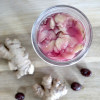In the fascinating world of lacto-fermentation, salt has long been considered an indispensable ingredient. However, a new wave of passionate fermenters and curious scientists is discovering that it is possible to create healthy and delicious fermented wonders without it. This article explores this culinary and scientific revolution, highlighting the fermentation of cabbage with a surprising ingredient: celery juice. .
Discover the nutritional benefits and preservation methods to makefermented foods without salt.
Lacto-Fermentation without Salt: A New Paradigm
Traditionally, Salt plays a crucial role. In lacto-fermentation, salt inhibits the growth of pathogenic bacteria. However, recent research reveals that it is possible to ferment vegetables without salt. By directly inoculating the ferment with beneficial lactic bacteria, an acidic environment is created where harmful bacteria cannot survive.
This dietary transition opens up new possibilities for people following a low-salt diet and enriches the culinary repertoire of fermentation. Making salt-free food preserves requires a little touch of patience to offer you a unique experience in the world of fermentation.
Celery: A Surprising Substitute
Celery juice, rich in flavors and nutrients, is emerging as an ideal substitute for salt in cabbage fermentation. By adding finely chopped or extracted celery juice to vegetables like cabbage, one not only introduces flavor but also creates a favorable environment for the proliferation of lactic bacteria. This innovative choice offers a unique and healthy taste dimension, thus opening the door to infinite possibilities through a simple process.
Understanding the science behind:
"La" lacto-fermentation involves the transformation of sugar into lactic acid by lactic acid bacteria (LAB). These bacteria thrive in acidic and anaerobic environments. Each species of LAB, adapted to specific ecological conditions, occupies a unique niche. In the fermentation process, different species of LAB become dominant at different stages, contributing to the complexity of flavors. These lactic acid-producing bacteria influence the flavor and texture of fermented foods.
Bacterial succession: A natural dance
This succession process, where different species of LAB take turns dominating the fermented environment, is comparable to natural ecological evolution. In the case of fermenting cabbage with celery juice, the LAB adapt to a salt-free environment, thereby altering the traditional fermentation profile and enriching the flavor.
Recipe 1: "Heavenly Sauerkraut with Celery Juice"
Ingredients:
- 1 large green cabbage
- 10 celery stalks
- Water (if necessary)
Required Materials:
- A large glass jar
- A pestle or a similar object to press down the cabbage.
- A juicer (if available)
Instructions:
- Preparation of the cabbage: Start by removing the outer leaves of the cabbage, then cut it into thin strips. Place the cabbage strips in a large bowl.
- Celery juice extraction: Use a juicer to extract the juice from the celery stalks. If you don't have a juicer, finely chop the celery and use a blender with a little water to create a thick juice.
- Mix: Pour the celery juice over the chopped cabbage. If the juice does not completely cover the cabbage, you can add a little water to ensure that the cabbage is well immersed.
- Compaction: Transfer the cabbage and celery juice mixture into the glass jar. Use the pestle to firmly pack the cabbage at the bottom of the jar. It is important that the cabbage is submerged in the liquid to prevent the growth of mold.
- Fermentation: Close the jar and leave it at room temperature for about 5 to 7 days. It is normal to see bubbles forming, which is a sign that fermentation is taking place.
- Control and Storage: Taste the sauerkraut after 5 days to check the acidity and texture. If it is to your liking, transfer it to the refrigerator. If not, let it ferment for a few more days.
Notes:
- The ideal ambient temperature for fermentation is around 18-22°C.
- Make sure your equipment is clean to avoid contamination.
- If mold appears on the surface, remove it; the rest of the product is generally still good.
This recipe for "Heavenly Sauerkraut with Celery Juice" offers a delicious and healthy alternative to traditional sauerkraut, perfectly suited for those following a low-salt diet. Prepared with raw ingredients, you can also use organic vegetables that embody the perfect fusion of health and indulgence, while highlighting respect for biodiversity.
Recipe 2: "Crunchy Carrot Delight with Celery"
Ingredients:
- 500 g of carrots
- 5 celery stalks
- 1 teaspoon of grains of black pepper (optional)
- 1 teaspoon of cumin seeds (optional)
- Water (if necessary)
Required Materials:
- A large glass jar with a lid
- A juicer (if available)
- A knife and a cutting board
Instructions:
- Preparation of vegetables: Wash and peel the carrots. Cut them into thin sticks. Wash the celery and cut it into small pieces.
- Celery juice extraction: If you have a juicer, use it to extract the juice from the celery stalks. Otherwise, finely chop the celery and blend it with a little water in a blender to obtain a thick juice.
- Assembly: In the large jar, alternate layers of carrot sticks and chopped celery. Add black peppercorns and cumin seeds between the layers for extra flavor.
- Adding celery juice: Pour the celery juice over the vegetables in the jar. Make sure the vegetables are completely submerged. Add water if necessary to cover the vegetables.
- Fermentation: Close the jar and leave it at room temperature for about 3 to 5 days. Check regularly and make sure the vegetables remain submerged.
- Control and Conservation: After a few days, taste to check if the flavor and texture are to your liking. Once ready, store the fermented vegetables in the refrigerator.
Notes:
- Keep the vegetables submerged to prevent mold formation.
- The ideal temperature for fermentation is around 18-22°C.
- Make sure that the jar and utensils are thoroughly cleaned to avoid any contamination.
This recipe for "Crunchy Carrot Delight with Celery" is perfect for a refreshing appetizer or a crunchy side dish, offering a unique touch to your fermentation palette. By savoring this condiment, you embark on an exciting journey through the complex world of lacto-fermentation, rediscovering a symphony of unique flavors and textures.
If you want to further master fermentation, visit ShiraBio webinars, a culinary creator and an outstanding fermentation expert.
Conclusion:
Salt-free lacto-fermentation, particularly with the addition of celery juice, opens new horizons in the art of fermentation. Not only is this method beneficial for those who need to limit their salt intake, but it also enriches the range of flavors available to fermentation enthusiasts. This scientific and culinary exploration marks an exciting step in our understanding and practice of lacto-fermentation, offering gastronomic treasures, food preservation possibilities, and a diet rich in variety and flavors.
Prof. Hacène FRIH
Bibliographic references:
Could you please provide the full text you would like translated? "Omotosho" appears to be a name and does not require translation., S.O., Ajayi, F.T., It looks like you have provided a list of names. Here is the translation: Boladuro, B., & Emerue, (Note: Names typically do not change when translating between languages.), P.C. (2022). A mixed ration of crop residues: effects on rumen fermentation characteristics and blood indices of West African dwarf sheep. Nigerian Journal of Animal Production.
Bossou, T.K. (2022). Production Characteristics and Food Safety of Bread - A Review. European Scientific Journal ESJ.
It looks like your message is incomplete. Could you please provide the full text you would like translated from French to English?, F.L. (2014). Development and oral breakdown of fiber-enriched and reduced-salt breads.
Sure, please provide the text you would like to be translated from French to English., O.S., Setyahadi, S., & Suryadi, H. (2009). IMMOBILIZATION OF LACTOBACILLUS ACIDOPHILUS FNCC116 CELLS FOR DEMINERALIZATION OF SHRIMP SHELL WASTE IN CHITIN PROCESSING.











